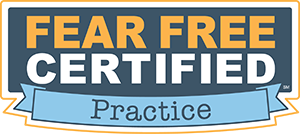In our previous posts, we have talked about Fear Free Certification and helping our pets to become more comfortable prior to veterinary visits. This month we’ll take a look into the Practice Certification process itself. Practice Certification takes the components of the Fear Free certification one step further and asks the entire practice to work together as a whole to achieve this goal. Similar to searching for a Fear Free Certified Individual, you as a pet parent are able to search for a practice that is certified.
What makes these practices a step above the rest is the fundamental commitment to the emotional well-being of their patients. To be eligible for certification, a practice must have 25% of the staff be Fear Free Certified and have an active membership AND that 25% must include 100% of the onsite managers and leadership and 50% +1 of all veterinarians. Practices are required to meet various standards of client education, medical record keeping, facility, community education, culture, leadership, training, and patient observation. Some categories are mandatory (which are pass/fail) and some have optional components (which are weighted). A practice must achieve a minimum score to pass each category. If a practice fails to meet a mandatory standard certification cannot be met until this is rectified. Once a practice is confident in their ability to pass the certification process an in-person meeting is scheduled with a Fear Free Consultant. The practice is then scored and certification submitted for final review. This certification is renewed annually and at the time of renewal 75% or more of the staff that has patient and/or client interaction should be certified with an active membership.
A multi-page document lists the Practice Certification Standards in addition to multiple webinars and podcasts to assist and guide the process. While this is available to those certified professionals it is not available to the general public but encompasses many of the topics we've discussed. Some examples of mandatory standards include:
- Physical and Emotional Standards including a veterinarian approving and supervising all patient care, FAS (Fear Anxiety and Stress) and pain evaluations occurring in every patient evaluation, and documentation of FAS protocols.
- Client Education Standards including brochures in the exam rooms and waiting areas and take home information about the various Fear Free components for all clients.
- Medical Records Standards including a pre-visit questionnaire and documentation of the Emotional Medical Record of each patient.
- Facility Standards including non-slip surfaces for patient handling and procedures and two items from a list of standards that improve the comfort of our patients.
- Culture, Training, and Leadership Standards which includes Fear Free in the practice mission statement, new hire process, and standard operating prochedures that affect patients and/or clients.
- Community Education and Marketing Standards and Patient Observation Standards are optional.
Fear Free Certified Practices have incorporated these standards into all aspects of their business, client and patient interactions and employee education. Their commitment to the emotional well-being of their clients and petients is evident in the standard of care they provide.
Next time we will delve into the signs of Fear, Anxiety, and Stress (FAS) and how we as pet parents and veterinary professionals can help to manage them.
Resources:
https://fearfreepets.com
https://fearfreehappyhomes.com
https://indoorpet.osu.edu
“From Fearful to Fear Free SM” written by Marty Becker, Lisa Radosta, Wailani Sung, and Mikkel Becker
*Article courtesy of Meaghan Ropski, DVM -- Fear Free Certified Professional

